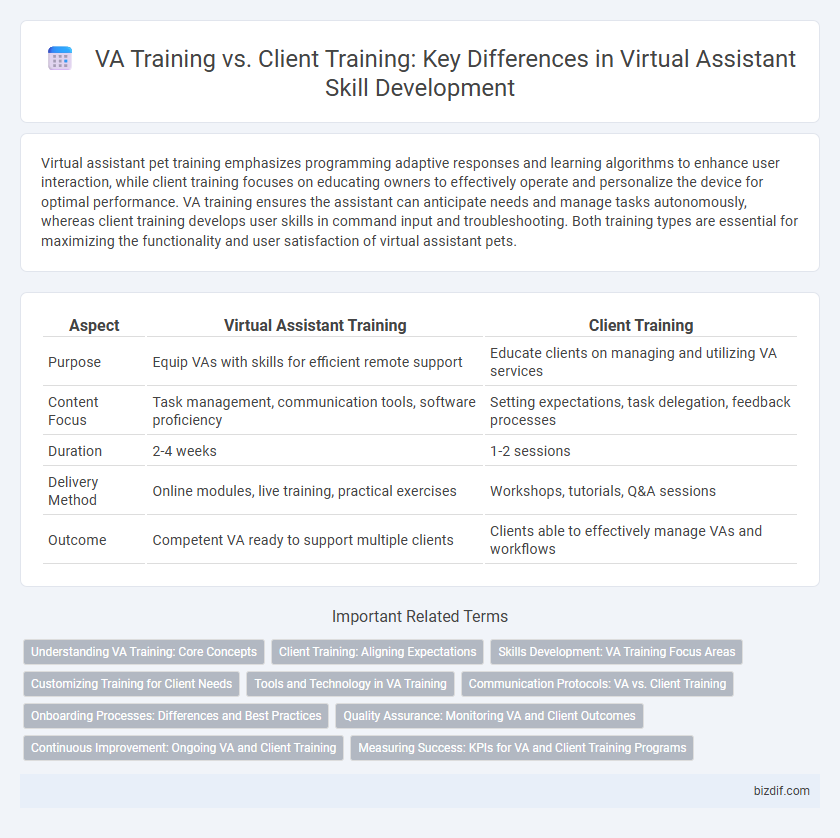Virtual assistant pet training emphasizes programming adaptive responses and learning algorithms to enhance user interaction, while client training focuses on educating owners to effectively operate and personalize the device for optimal performance. VA training ensures the assistant can anticipate needs and manage tasks autonomously, whereas client training develops user skills in command input and troubleshooting. Both training types are essential for maximizing the functionality and user satisfaction of virtual assistant pets.
Table of Comparison
| Aspect | Virtual Assistant Training | Client Training |
|---|---|---|
| Purpose | Equip VAs with skills for efficient remote support | Educate clients on managing and utilizing VA services |
| Content Focus | Task management, communication tools, software proficiency | Setting expectations, task delegation, feedback processes |
| Duration | 2-4 weeks | 1-2 sessions |
| Delivery Method | Online modules, live training, practical exercises | Workshops, tutorials, Q&A sessions |
| Outcome | Competent VA ready to support multiple clients | Clients able to effectively manage VAs and workflows |
Understanding VA Training: Core Concepts
VA training emphasizes mastering task management, communication protocols, and software proficiency critical for efficient client support. Client training focuses on setting expectations, task delegation, and feedback mechanisms to optimize collaboration with VAs. Understanding VA training's core concepts ensures alignment of skills with client needs, enhancing productivity and service quality.
Client Training: Aligning Expectations
Client training in virtual assistant services focuses on aligning expectations to ensure clear communication and task understanding. Establishing detailed guidelines and performance metrics helps clients articulate their needs effectively, which enhances the VA's productivity and satisfaction. Properly aligned expectations reduce miscommunication, streamline workflows, and contribute to long-term client-VA success.
Skills Development: VA Training Focus Areas
VA training emphasizes advanced communication, task management, and problem-solving skills tailored to virtual environments, ensuring seamless support across various digital platforms. Client training prioritizes understanding organizational goals and specific project requirements to align virtual assistant output with business needs. Skill development in VA training includes technology proficiency, time management, and adaptability to enhance remote collaboration efficiency.
Customizing Training for Client Needs
Customizing training for client needs enhances virtual assistant (VA) performance by aligning skill development with specific business goals and industry requirements. Tailored VA training incorporates client-specific workflows, software tools, and communication preferences, ensuring seamless integration and increased efficiency. Personalized training boosts client satisfaction and operational productivity by addressing unique challenges and optimizing task management.
Tools and Technology in VA Training
Virtual assistant training emphasizes mastering a wide range of tools and technology such as project management software, communication platforms, and automation apps to enhance efficiency and client satisfaction. Comprehensive VA training includes hands-on experience with CRM systems, scheduling tools, and AI-powered virtual assistant platforms to ensure seamless task execution. This technology-focused approach equips virtual assistants with the skills to adapt quickly to diverse client needs and workflows.
Communication Protocols: VA vs. Client Training
Effective communication protocols differ significantly between VA training and client training as VAs require structured guidelines to manage multiple client preferences efficiently, while client training focuses on clear instructions to optimize task execution. VA training emphasizes standardized communication tools, response timing, and confidentiality measures to ensure consistent service delivery across varied assignments. Client training, however, prioritizes understanding VA capabilities and providing precise feedback to enhance collaboration and task accuracy.
Onboarding Processes: Differences and Best Practices
Virtual assistant training centers on equipping VAs with versatile skills, task management, and communication protocols to efficiently support multiple clients. Client training emphasizes familiarizing clients with the VA's tools, workflows, and communication channels to foster seamless collaboration. Effective onboarding combines clear expectations, resource accessibility, and continuous feedback to optimize productivity and relationship success.
Quality Assurance: Monitoring VA and Client Outcomes
Quality assurance in virtual assistant (VA) training emphasizes continuous monitoring of VA performance metrics and client satisfaction scores to ensure service excellence. Client training focuses on setting clear expectations and providing tools for effective collaboration, directly impacting VA outcomes and overall project success. By integrating both VA and client training, organizations optimize communication flows and achieve higher quality results through consistent performance evaluations and feedback loops.
Continuous Improvement: Ongoing VA and Client Training
Continuous improvement in virtual assistant and client training drives enhanced performance and stronger collaboration. Ongoing VA training ensures assistants stay updated on the latest tools, communication techniques, and industry-specific knowledge. Simultaneously, continuous client training fosters clear expectations, effective feedback loops, and optimized workflows for seamless project execution.
Measuring Success: KPIs for VA and Client Training Programs
Measuring success in Virtual Assistant (VA) training programs involves tracking KPIs such as task proficiency, response time, and client satisfaction rates to ensure efficient skill development and performance optimization. Client training programs focus on KPIs like user adoption rates, training completion percentages, and feedback scores to gauge the effectiveness of onboarding and ongoing support. Both VA and client training KPIs provide critical data-driven insights for continuous improvement and alignment with organizational goals.
VA training vs Client training Infographic

 bizdif.com
bizdif.com